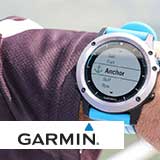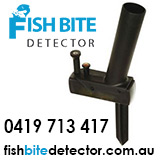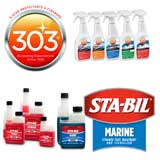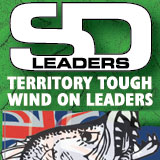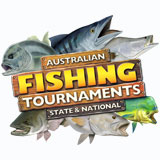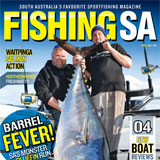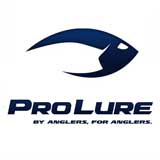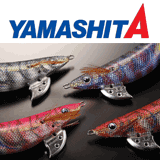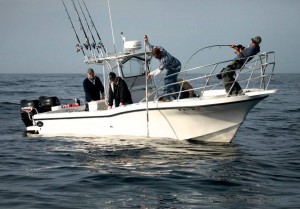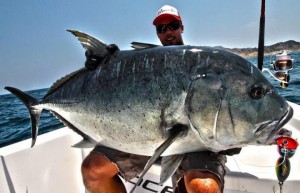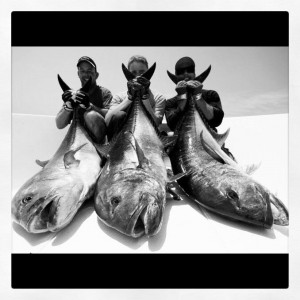Species ID
View AllGiant Trevally

Giant trevally, hereon referred to as GT, are a member of the Jack family Carangidae (know in Australia as Trevallies). They are the largest growing member of the genus Caranx, and are known for their immense power and high speed. They are thick and muscular through the body with a steep sloping forehead and a row of sharp horizontal scutes along the lateral line between the dorsal fin and tail. Pattern and colour varies greatly in this species and individuals can display silvery grey to jet-black colouration and none to numerous tiny black dots scattered across the body.
Other names
GT, Ulua, Lowly Trevally, Barrier Trevally
Common size
4-15kg
Related species
Bluespotted trevally, Tille trevally, Brassy trevally, Bigeye trevally.
Lifespan
Over 20 years
Habitat
GT are predatory in nature and tend to inhabit marine environments rich in baitfish from coastal estuaries, beaches and sand flats to coral reefs and atolls, with larger adults preferring the later two examples. In the reef environment GT are often found cruising the wave swept whitewater edges as they search and hunt for prey.
Reproduction
GT are large growing and can reach sizes of 80kg or more and 170cm in length. They are relatively fast-growing and mature at approximately 95-96cm and five years of age. Spawning adults can form massive congregations but outside of these times larger adults are often solitary (but not always) with a home range limited to an area of reef of their own.
Diet
GT are powerful apex predators that will just about anything but predominately feed on baitfish. Within reef environments they have a particular preference for fusiliers and will even eat other predators such as tuna and mackerel. Other organisms making up their diet include crustaceans, squid, octopus, crabs and eels.
Pound for pound
GT are an extremely powerful fish and are a prized capture for anglers globally. Pound for pound GT are one of the hardest fighting fish in the ocean, some would argue they are the toughest.
Catch care
GT are generally targeted as a catch and release sport fish in Australia and this philosophy is strongly encouraged by Get Fishing. However, some people may choose to keep one when in need of a feed so if you’re going to take one for a feed look after it properly. Immediately dispatch of the fish humanely, bleed it, and place in a salty ice slurry until you get home.
Information courtesy of Che Carson, Perth WA and Department of Fisheries WA. Photos courtesy of Rock Wyrsta, Sydney NSW. Visit gtpopping.com for more details.
Where to fish
Giant trevally (GT) inhabit coastal and offshore waters from the central Western Australian coast north around to the central coast of New South Wales. GT’s are wide ranging and can be found cruising in shallower nearshore as well as offshore reef structures such as coral reefs and atolls, pinnacles and drop-offs. When targeting GT’s look for washy areas where bait are holding up, particularly fusiliers around offshore reefs and atolls.
How to target
Giant trevally will take live or dead whole fish and fillet baits as well as soft plastics and trolled minnows, but by far the most exciting and sporting way to target them is on large surface lures like poppers and stickbaits.
When targeting GT’s by boat pull up in deeper water within casting distance of an area of interest, a reef outcrop for example, and cast large poppers or stickbaits towards the reef edge and work the lure back to the boat, imparting as much action to the lure as possible. Upon hookup drive the fish off the reef fast!
Rod & Reel
Minimum rod length for casting of 7ft and up to 9 ft. Preferably choose a strong, lightweight graphite rod rated PE 6-10 to suit the lure size and area you plan to fish. A lower cost example would be the Azusa 902H or for high end Carpenter Monster Hunter and Blue Lagoon.
A quality reel is advisable for example Shimano Stella, Sustain, Biomaster size10000-20000 or the Daiwa Saltiga or Saltist size 4500-6500.
Line and leader
- Mainline PE 6-10 braid
- Min.100-200lb leader, fluorocarbon preferred
Terminal Tackle
- Quality high breaking strain crane swivel
- Quality high breaking strain split ring
- Quality trebles e.g. Owner Stingers or Decoys
Best Lures
Large poppers such as Dumbbells, Black Jack Cubera and Tuna, Hammerheads, Fishermans, Carpenters etc, and large stickbaits such as Black Jack Ulua, Shimano Ocea, Daiwa Dorodo, etc.
Best Bait
Live whole or dead fish caught on location. Fillet baits can work but not as well.
Filleting
We strongly encourage catch and release fishing for this for this highly regarded sport fish.
Rigging for lure casting
This method involves casting and retrieving large poppers or stickbaits over and around reef structure. Join your braided mainline to: a) a twisted leader by tying a Bimini twist, or b) a single strand leader by tying a FG knot, PR knot, Fingertrap knot or similar. At the other end of the leader attach a quality crane swivel by tying a Uni knot, Chain knot or similar (even when using a twisted leader). Connect the swivel directly to a quality split ring on the lure and you’re away.
Rigging for live baiting
This method involves fishing live whole fish baits from the shore, jetties, or boat. Keep the rig simple; connect the mainline to a basic rig (as pictured right) consisting of a 6/0-10/0 hook, 100-200lb leader (preferably fluorocarbon) and a quality high breaking strain crane swivel. Insert the hook through the nose or shoulder of a live baitfish such as Fusilier, Herring, Mullet or similar. For dead whole fish baits or fillets use the same rig just insert a running ball sinker between the swivel and hook.
Hints & tips
Giant trevally are generally caught around coastal offshore reefs from the central WA coast north around to the central NSW coast. Anglers target them with high quality, strong, lightweight outfits using large poppers and stickbait lures.
- When a fish follows don’t speed up the retrieve. Keep doing what you are doing and even throw in a pause if they are still not hitting.
- In calmer conditions work poppers with a slower retrieve with big sweeps of the rod to displace more water.
- Always be ready for a strike. You will often get hit as soon as the lure hits the water.
- In calmer conditions or when the fish are less aggressive use stickbaits with an aggressive walk-the-dog technique with the rod tip down to get the lure darting.
Information courtesy of Che Carson, Perth WA and Department of Fisheries WA. Photos courtesy of Rock Wyrsta, Sydney NSW. Visit gtpopping.com for more details.
GT are distributed throughout the tropical waters of the Indian and Western Pacific Oceans. In Australia they generally range between Carnarvon in Western Australia northward to northern New South Wales.
3 stars. Like many of the trevallies GT are not a renown table fish in Australia, and bigger fish over 10kg are said to be poor eating. In other countries throughout the tropics GT are less frowned upon and make up a significant part of the fish intake in many cultures. In countries such as Fiji for example, the locals wrap the fish in banana leaves and cook whole on the coals of an open fire. When cooked right using this method even the flesh of large specimens is chunky, white, soft and juicy and actually quite tasty.

- Are a member of the family Carangidae (jacks and scads)
- Grows up to 1.7m in length
- Can reach 80kg in weight
- Juveniles commonly form schools whereas larger adults are often solitary
- Can be either silver or jet-black in colour
- Are the largest growing member of the genus Caranx.

